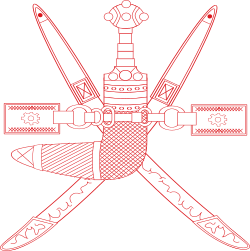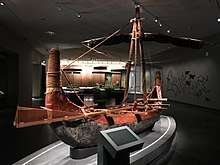Magan (civilization)
Magan (also Makkan[1]) was an ancient region which was referred to in Sumerian cuneiform texts of around 2300 BC and existed to 550 BC as a source of copper and diorite for Mesopotamia.
Part of a series on the |
|---|
| History of Oman |
 |
|
|
Location
The location of Magan is not known with certainty, but most of the archaeological geological evidence suggests that Magan was part of what is now the United Arab Emirates and Oman.[2] However, some archaeologists place it elsewhere, such as in the region of Yemen known as Ma'in,[3] in the south of Upper Egypt, in Nubia or the Sudan, and others as part of today's Iran and Pakistan. The latter location, specifically in the neighborhood of coastal Baluchistan, has been suggested on account of the similarity between Baluchistan's historical name, "Makran", and "Makkan", a variant of Magan.[4]
History

The first Sumerian mentions of a land of Magan (Sumerian 𒈣𒃶 Magan, Akkadian Makkan) are made during the Umm al-Nar period (2600–2000 BCE), as well as references to 'the Lords of Magan'. Sumerian sources also point to 'Tilmun' (accepted today as being centered in modern Bahrain) and Meluhha (thought to refer to the Indus Valley).[5] Akkadian campaigns against Magan took place in the twenty-third century BCE, again possibly explaining the need for fortifications, and both Manishtusu and Naram-Sin and Manishtusu, in particular, wrote of campaigning against '32 lords of Magan'.[5]
_Magan_Meluha_with_transcription.jpg)
Naram-Sin gave the Akkadian title Malek to the defeated Ruler of Magan, a title which survives in the Arabic for king, malek.[8]
Magan was famed for its shipbuilding and its maritime capabilities. King Sargon of Agade (2371–2316 BCE) boasted that his ports were home to boats from Tilmun, Magan and Meluhha. His successor, Naram-Sin, not only conquered Magan, but honoured the Magan King Manium by naming the city of Manium-Ki in Mesopotamia after him. Trade between the Indus Valley and Sumer took place through Magan, although that trade appears to have been interrupted, as Ur-Nammu (2113–2096 BCE) laid claim to having 'brought back the ships of Magan'.[9]
Commerce
Archaeological finds dating from this time show trade not only with the Indus Valley and Sumer, but also with Iran and Bactria.[10] They have also revealed what is thought to be the oldest case on record of poliomyelitis, with the distinctive signs of the disease found in the skeleton of a woman from Tell Abraq, in modern Umm Al Quwain.[10]
Trade was common between Magan and Ur before the reigns of the Gutian kings over Ur. After they were deposed, Ur-Nammu of Ur restored the roads and trade resumed between the two nations (c. 2100 BC).[11]
See also
References
- Boats of the World
- M. Redha Bhacker and Bernadette Bhacker. "Digging in the Land of Magan". Archaeological Institute of America.
- F. Hommel, Ethnologie und Geographie des alten Orients, (Handbuch der klassischen Altertumswissenschaft von W. Otto, III. Abtl. I, Teil, Bd. I, Munich 1926), 550, 578 ff.
- John Lawton. "Oman - The Lost Land". Saudi Aramco World (May/June 1983): 18–19. Archived from the original on 26 October 2014.
- United Arab Emirates : a new perspective. Abed, Ibrahim., Hellyer, Peter. London: Trident Press. 2001. p. 40. ISBN 978-1900724470. OCLC 47140175.CS1 maint: others (link)
- "I will spread in the world respect for my Temple, under my name the whole universe will gather in it, and Magan and Meluhha will come down from their mountains to attend" "J'étendrai sur le monde le respect de mon temple, sous mon nom l'univers depuis l'horizon s'y rassemblera, et [même les pays lointains] Magan et Meluhha, sortant de leurs montagnes, y descendront" (cylinder A, IX:19)" in "Louvre Museum".
- "The Electronic Text Corpus of Sumerian Literature". etcsl.orinst.ox.ac.uk.
- Tosi, Maurizio (1986). "The Emerging Picture of Prehistoric Arabia". Annual Review of Anthropology. 15: 461–490. doi:10.1146/annurev.an.15.100186.002333. ISSN 0084-6570. JSTOR 2155769.
- Donald., Hawley (1970). The Trucial States. London: Allen & Unwin. p. 27. ISBN 978-0049530058. OCLC 152680.
- United Arab Emirates : a new perspective. Abed, Ibrahim., Hellyer, Peter. London: Trident Press. 2001. p. 43. ISBN 978-1900724470. OCLC 47140175.CS1 maint: others (link)
- Hamblin, William J. Warfare in the Ancient Near East to 1600 BC. New York: Routledge, 2006.